|
A pyramid is a polyhedron with one base, which is a polygon, and lateral faces that are triangles converging to a single point at the top. |
|
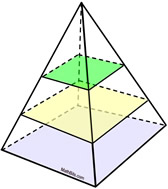 Similar Cross Sections
Similar Cross Sections
(parallel to base) |
• |
The one and only base of the pyramid is a polygon (no circles or ovals). |
• |
Pyramids are also called polyhedra since their faces are polygons. |
• |
The lateral faces are always triangles with a common vertex. |
• |
The vertex of a pyramid (the point, the apex) is not in the same plane as the base. |
• |
All cross sections of a pyramid parallel to the base will be similar to the base. |
|
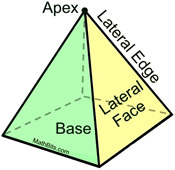 Right Square Pyramid
Right Square Pyramid
|
Pyramids are named for the shapes of their bases.
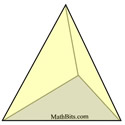 Triangular Base
Triangular Pyramid
Triangular Base
Triangular Pyramid |
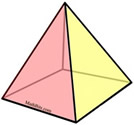 Square Base
Square Pyramid
Square Base
Square Pyramid |
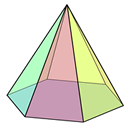 Hexagonal Base
Hexagonal Pyramid
Hexagonal Base
Hexagonal Pyramid |
Regarding heights:
The most commonly seen pyramid is a regular pyramid, which is a right pyramid whose base is a regular polygon and whose lateral edges are congruent. In a regular, right pyramid, the height(altitude) is measured from the vertex (the top) perpendicular to the base. The point of intersection with the base will be the center of the base. Slant height refers to the height (altitude) of each lateral face. |
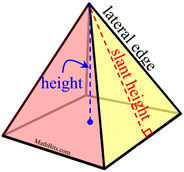 |
Regarding lateral faces:
In a regular pyramid, the lateral faces are congruent isosceles triangles.
|
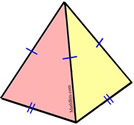 |
Oblique pyramids:
If a pyramid is oblique, its height (altitude) is also measured from the vertex perpendicular to the base. In this case, however, the point of intersection with the base will not be the center of the base. It may even be the case that the height is outside of the pyramid.
|
|

Volume of a Pyramid:
The volume of a pyramid is one-third the area of its base
times its height. |
|
|
We know that V = Bh is the formula for the volume of a prism. By examining the formula of a pyramid, we could state that the volume of a pyramid is exactly one third the volume of a prism with the same base and height.
Justification of formula by "pour and measure":
(For this discussion, our pyramid will be a right square pyramid.)
We can conduct an experiment to demonstrate that the volume of a pyramid is actually equal to one-third the volume of a prism with the same base and height. We will fill a right square pyramid (whose height happens to be equal to the side of its base) with water. When the water is poured into a prism (a cube) with the same base and height as the pyramid, the water fills one-third of the prism (cube).
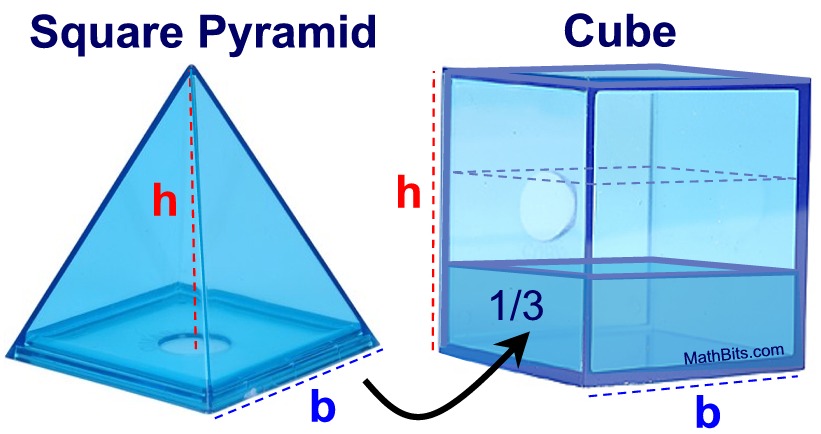 |
| • |
The base of the pyramid is a square, with an area of b2. |
| • |
The base of the cube is a square, with
an area of b2. |
| • |
The height of the pyramid and the cube is h. |
| • |
In this example, b = h. |
|
By measurement, it can be concluded that the height (depth) of the water in the cube is one-third the height of the cube.
Since the formula for the volume of the cube is V = Bh, it follow that the volume of the pyramid can be represented by  .
.

Justification of formula by "dissecting a cube":
Since we know the formula for the volume of a cube (V = b3), and the cube is an easy solid with which to work, let's start with the cube and a regular square pyramid.
Regular Pyramid
Square Base
 The base is congruent to the base of the cube.
The base is congruent to the base of the cube.
The height is half the height of the cube.
|
|
How many square pyramids will fit inside the cube when they have the same base as the cube and half of the height?
|
A total of 6 pyramids can fit inside this cube, as long as the pyramids' bases are the same as the base of the cube, and the heights of the pyramids are half the height of the cube (b). So the volume of one pyramid is one-sixth the volume of the cube. 
This dissecting a cube into 6 congruent pyramids only works because the height of the pyramid is half the height of the cube. What happens if the height is not half the height of the cube? We will need the formula to contain a variable to deal with the height of the pyramid.
Since h = ½ b, we have 2h = b. Using substitution, we get: .
.
This example can be generalized to the statement "the volume of a pyramid is equal to one-third the volume of a prism (V = Bh) with the same base and height as the pyramid."
The volume of a pyramid formula generalizes to

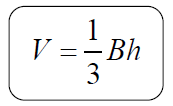

Surface Area of a Pyramid:
The surface area of a pyramid is the sum of the area of the base plus the areas of the lateral faces. (The sum of the areas of all the faces.) |
|
Right, Regular, Square Pyramid
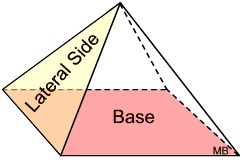
Surface Area, S, of a regular pyramid:
S = B + ½ps
B = area of pyramid's base
p = perimeter of pyramid's base
s = slant height (height of lateral side)
|
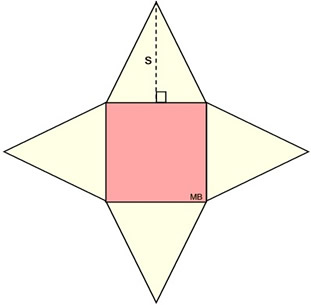
A net of the pyramid shows the "surfaces" whose areas, when added, comprise the surface area.
|








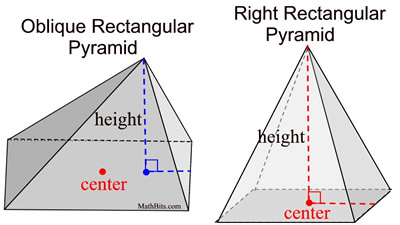


 .
.
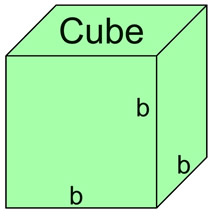
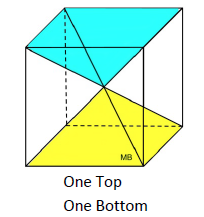
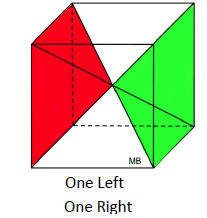
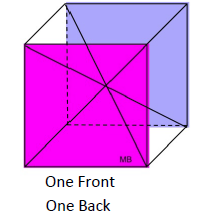

 .
.


